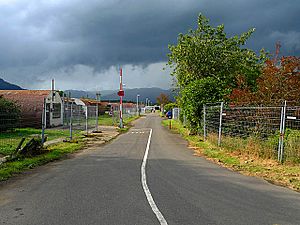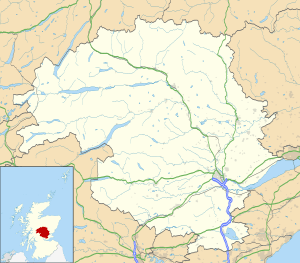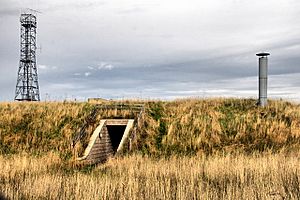Cultybraggan Camp facts for kids
Quick facts for kids Cultybraggan Camp |
|
|---|---|
| Comrie | |

Entrance to Cultybraggan Camp
|
|
|
Location within Perth and Kinross
|
|
| Coordinates | 56°21′20″N 03°59′39″W / 56.35556°N 3.99417°W |
| Type | Prisoner of War Camp |
| Site information | |
| Owner | Comrie Development Trust |
| Operator | Comrie Development Trust |
| Site history | |
| Built | 1941 |
| Built for | War Office |
| In use | 1941–2004 |
Cultybraggan Camp is located near the village of Comrie in west Perthshire, Scotland. It was first used as a prisoner of war (PoW) camp during World War II. After the war, it became a training area for the Army.
Later, it also housed a Royal Observer Corps (ROC) nuclear monitoring post. It also had a Regional Government Headquarters (RGHQ). Some training areas nearby are still used by the Ministry of Defence today.
Contents
History of Cultybraggan Camp
World War II Prisoner Camp
Cultybraggan was built in 1941. It was known as PoW Camp No 21. The camp was designed to hold 4,000 prisoners. It was a special 'black camp' for prisoners considered very strong supporters of Nazi ideas. Most of these were young soldiers from the Waffen-SS, Fallschirmjäger (paratroopers), and U-boat crews.
Prisoners from different parts of the German military were kept in separate areas. For example, Army, Kriegsmarine (Navy), Air Force, and SS prisoners had their own compounds. Officers were also kept apart. Another smaller camp was located two miles away at Cowden.
One famous prisoner was Heinrich Steinmeyer. He was a soldier in the Waffen SS. He was captured in Normandy in August 1944. When he died in 2014, he left a large gift of £384,000 to the village of Comrie. This money is now part of the Heinrich Steinmeyer Legacy Fund.
After the War: Training Camp
After World War II, Cultybraggan became a training camp in 1949. It was used by the Regular Army and the Territorial Army. It was also very popular with Cadet units for their yearly camps.
The camp covered about 8 acres. It could house 600 people in huts and tents. Soldiers used the nearby 12,000-acre Tighnablair Training Area. They practiced things like adventure training and driving off-road.
Many of the original 100 Nissen huts are still there. Some were removed in the 1970s for a firing range. The remaining huts are important because they show what a World War II prisoner of war camp looked like. In 2006, many buildings at the camp were officially protected as listed. Some huts are even 'category A listed', meaning they are very important to the nation's history.
Cold War Defence Site
During the Cold War, an underground Royal Observer Corps (ROC) monitoring post was built here in 1960. This post was used to watch for nuclear attacks. It closed in 1991, but you can still visit it.
In 1990, a large underground bunker was finished. This was a Regional Government Headquarters (RGHQ). It was meant to be a safe place for important government leaders if there was a war. The Secretary of State for Scotland, the BBC, and other key groups would have worked from here. However, the Cold War ended soon after the bunker was built. The bunker was then sold to the Army and used for military training.
Cultybraggan Today: Comrie Development Trust
The military stopped using Cultybraggan Camp in 2004. In 2007, the Comrie Development Trust bought the camp. This was done through a special community right-to-buy option. The Trust paid £350,000 for the 90-acre site.
Since then, the Trust has been working to improve the camp. They have fixed things like drainage, electricity, and water. They have also changed nine Nissen huts into 12 spaces for local businesses. The main mess hall has also been updated.
In 2014, the underground bunker was sold at an auction. A company bought it to use for storing important digital information and media.
Images for kids







